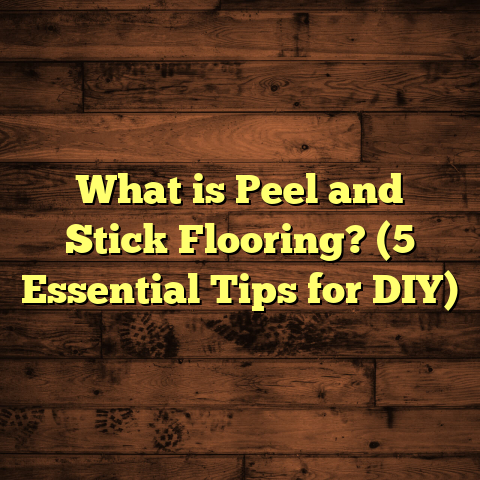What is Scribe and Seal in Flooring? (5 Key Insights Revealed)
Do you remember those moments when you were a kid, watching someone work on the floors at home or maybe at a neighbor’s place? The way the floor seemed to awkwardly meet the walls or cabinets always caught my attention—and not in a good way. Sometimes, there were little gaps or uneven edges that made the whole room look unfinished, like something was missing. Even as I got older and started working in flooring myself, I realized this is a problem a lot of people face. And that’s when I really got interested in Scribe and Seal, a technique that’s saved me countless headaches and helped make floors look absolutely perfect.
If you’ve ever wondered how professionals get floors to fit so flawlessly along uneven walls or tricky corners, then you’re in the right place. I’ll walk you through everything about scribing and sealing—from what it is, why it matters, the tools I use, challenges you might face, how it saves money, and some tips from my own experience. Trust me, by the time you finish this, you’ll see why this is a must-know for anyone serious about flooring.
What Is Scribe and Seal in Flooring?
Alright, let’s start with the basics. What is scribe and seal?
In simple terms, scribe and seal is a method where the edge of your flooring material—whether it’s hardwood, laminate, vinyl plank, or engineered wood—is carefully cut to match the exact shape of the wall or other vertical surfaces it meets. After shaping, the gap between the floor and wall is sealed to protect against dirt, moisture, and pests while giving a clean, finished look.
Why do we need this?
If your walls were perfectly straight and your floorboards perfectly uniform, installation would be a breeze. But in reality, especially with older homes or buildings that have settled over time, walls often bow or curve slightly. Even new construction can have minor imperfections.
When you lay flooring without adjusting for these irregularities, you end up with unsightly gaps or edges that don’t sit flush. The floor might look like it’s floating awkwardly next to the wall or baseboard, which ruins the whole aesthetic.
The scribe part is all about custom-fitting the floor edges. You trace the exact contour of the wall onto your floorboard using a scribing tool or compass. Then you cut along that line to make sure it fits perfectly.
The seal part comes afterward—you fill any tiny gaps left with caulk or filler designed for flooring. This keeps moisture out (which can damage wood floors), stops dirt buildup, and prevents bugs from sneaking in.
How does this look in practice?
I remember one job where I was installing hardwood in a historic farmhouse. The walls were far from straight—some spots bowed out almost half an inch over just a few feet. If I had just cut the boards straight and pushed them against those walls, you’d see big gaps all around.
Instead, I used my scribe tool to carefully trace those curves onto each board. It took longer, but once cut and sealed, the floor looked like it was meant for that space all along. The homeowner was thrilled because it looked smooth and professional—no gaps or ugly edges.
1. Why Scribe and Seal Matters for Flooring Quality
You might think this sounds like extra work that isn’t really necessary. But here’s why scribe and seal actually makes a huge difference in both how your floor looks and lasts.
Hides Imperfections
One of the biggest reasons to scribe is to hide those imperfections that come from uneven walls or baseboards. Even in new construction homes, perfectly straight walls are rare. When floors meet these imperfect surfaces without scribing, it’s obvious.
The scribing process provides a custom fit so that each board nestles perfectly against whatever surface it touches—whether it’s a curved wall, radiator pipe, or cabinet toe kick.
Keeps Dirt and Moisture Out
Gaps between flooring and walls aren’t just ugly—they invite problems. Dirt settles into these cracks making cleaning harder. More importantly, moisture can seep into gaps which can cause wood floors to warp or laminate flooring to delaminate.
Moisture intrusion is especially dangerous in rooms like kitchens or basements where humidity levels fluctuate.
Pest Prevention
This might surprise some people: tiny gaps left near walls are basically open doors for insects or rodents to enter. When you seal these gaps after scribing, you’re blocking their path.
I’ve seen plenty of cases where poorly sealed floors led to pest issues later on. Sealing is simple but effective prevention.
Improves Durability
When floorboards fit perfectly and are sealed properly at their edges, they’re less likely to move around over time due to expansion or contraction caused by temperature changes.
This means fewer squeaks, less warping, and longer-lasting floors. The initial time investment pays off big in lasting quality.
Boosts Resale Value
If you ever plan to sell your home, small details like tight-fitting floors make a difference. Buyers associate clean finishes with care and quality workmanship.
According to a survey by Remodeling Magazine’s Cost vs. Value Report (2023), homes with high-quality flooring improvements recoup about 70-75% of their cost at resale—and well-installed floors with scribe and seal tend to rate higher in quality perception.
2. Tools and Techniques I Use for Scribing and Sealing
Let me give you an insider look at what I actually use on-site every day when doing scribe and seal work.
The Scribe Tool / Compass
The star of the show is definitely the scribe tool (sometimes called a contour gauge or compass). It has two adjustable arms with sharp points:
- One point rests against the uneven wall.
- The other draws the exact shape onto your flooring material.
The tool transfers every bump and curve precisely so your cut line matches perfectly.
Pencil or Marker
After setting the scribe tool against the wall and moving it along as you go, I mark the outline on the edge of my floorboard with a pencil. Sometimes I shade slightly inside the line to know where to cut exactly.
Jigsaw or Coping Saw
For cutting along the scribed line, I rely on a jigsaw for hardwood or laminate because it gives clean cuts even on curves.
For smaller trims or delicate cuts near pipes and corners, a coping saw works great.
Caulk Gun with Flexible Sealant
Sealing comes after cutting. I use an acrylic latex caulk that remains flexible but dries paintable for a seamless finish.
Using a caulk gun makes applying smooth beads easy.
Putty Knife or Finger
To smooth out caulk lines after application, I use either a putty knife or just a wet finger—whichever gives better control on that job.
Measuring Tape
Never underestimate measuring twice! I always double-check dimensions before cutting because mistakes cost time and materials.
How I Approach Scribing Step-by-Step
Here’s a quick rundown of my workflow:
- Prepare the area: Clean walls and floor edges so nothing interferes with tracing.
- Set scribe tool: Adjust one arm against the wall surface.
- Trace shape: Move tool along wall edge while transferring contour onto floorboard.
- Mark cutting line: Use pencil to finalize cut line based on scribe marks.
- Cut: Follow line carefully with jigsaw/coping saw.
- Dry fit: Place board against wall to check fit.
- Make adjustments: If needed, fine-tune cut edges.
- Seal: Apply caulk/filler along gap to finish neat edge.
- Clean up: Wipe away excess sealant before drying.
3. Common Challenges with Scribe and Seal (and How I Handle Them)
Even with years of experience, scribing isn’t always smooth sailing. Here are some common problems I’ve faced—and solutions you can try:
Uneven Walls
Walls that bow significantly more than half an inch can be tough because one continuous cut won’t fit perfectly all along the board length.
Solution: Break your work into sections. Scribe smaller segments independently so each fits its part of the wall snugly.
This takes patience but guarantees better results than forcing one long board shape.
Hard-to-Reach Areas
Corners behind radiators or narrow spaces around cabinets can make using scribe tools impossible.
Solution: Use cardboard templates cut by hand to trace shapes when tools won’t fit. This old-school method works surprisingly well for tricky spots.
Inaccurate Measurements
Sometimes walls shift slightly as you move along them, causing your initial marks to be off when you get to the other side of a board.
Solution: Constantly recheck measurements at multiple points instead of trusting one continuous tracing.
Make small adjustments along the way rather than trying to perfect everything at once.
Sealant Problems
Some sealants crack after drying or don’t stick well to certain floor materials.
Solution: Test different caulks on scrap pieces before starting big jobs. Acrylic latex caulk is usually reliable but silicone-based sealants can work better in high-moisture areas like bathrooms.
Time Constraints
Scribing is slower than just cutting straight edges—sometimes clients want quick installs.
Solution: Explain benefits clearly upfront so clients understand why precision matters for long-term quality—and schedule accordingly.
4. How Scribe and Seal Saves Money Long-Term
I know what you might be thinking: “All this careful measuring and sealing sounds like extra time—and money.”
But here’s what I’ve learned from years on job sites: spending time on scribing actually saves money down the line.
Fewer Repairs Needed
Floors installed without proper scribing often develop gaps as wood expands/contracts with humidity change. These gaps need fixing later—either with new trim or re-cutting boards—which costs more than doing it right initially.
Water Damage Prevention
Moisture getting under floor edges can cause warping or mold growth that leads to expensive repairs or even full replacement later on.
Sealing those edges keeps water out effectively.
Increased Property Value
Professionally finished floors add value when selling homes because buyers notice details like tight-fitting edges versus sloppy cuts.
According to Remodeling Magazine data (2023), quality flooring installations recoup about 70-75% of their cost at resale—scribe-and-seal work contributes significantly to perceived quality.
Less Regular Maintenance
Tightly sealed edges reduce dirt buildup that wears down finishes faster—meaning floors stay beautiful longer without frequent cleaning or refinishing costs.
5. Tips from My Experience for DIYers Wanting Perfect Floors
If you want to try scribe and seal yourself (and it’s totally doable with patience), here are some of my best tips:
Take Your Time Tracing
Don’t rush the scribing step—it sets everything else up for success. Move slowly along walls holding your tool steady for accurate contours.
Practice on Scrap Boards First
Before cutting your real flooring pieces, scribe and cut scraps to get comfortable with your tools and technique.
Use Painter’s Tape When Sealing
Mask off edges with painter’s tape before applying caulk so lines stay neat and don’t smear onto visible parts of the floorboard.
Keep Lighting Bright
Good light helps you see wall contours clearly when tracing—and notice pencil marks better for cutting accuracy.
Get Help if You Can
Having an extra set of hands holding boards steady makes tracing and fitting easier—especially on larger planks or tricky spaces.
Bonus: Real-Life Case Study from One of My Projects
I want to share a detailed example from a recent job where scribe and seal made all the difference:
The Project
A client had an old craftsman-style home with original plaster walls that curved irregularly around several rooms. They wanted new oak hardwood floors installed throughout main living areas but were worried about how floors would look against uneven walls.
The Challenge
The walls bowed inward up to ¾ inch in spots over lengths up to 10 feet—too much for standard straight cuts without leaving big gaps.
My Approach
- Used scribe tool on every board edge touching walls.
- Broke boards into smaller sections for tightest fit.
- Cut each piece carefully following scribed lines.
- Sealed all edges with flexible acrylic caulk.
- Painted over sealant for perfect color match with baseboards.
Result
The floors fit so tightly that no gaps were visible anywhere—even under close inspection by client’s friends who are interior designers!
Best part? Homeowner reported zero issues after one year—no drafts, no pests—and maintenance was easy since no dirt collected in cracks.
Wrapping Up My Thoughts on Scribe and Seal
Scribing and sealing may seem like small steps in flooring installation but they make an enormous difference in appearance, durability, cleanliness, and value.
From my personal experience starting out as an apprentice fumbling through my first hardwood install, to now managing complex jobs where precision counts most—this technique has been indispensable.
If you’re thinking about installing floors yourself or hiring professionals, ask about how they handle edges near walls—if they skip scribing, expect less-than-perfect results down the road.
Thanks for sticking with me through all these details! Next time you walk into a room with gorgeous floors fitting snugly against every wall curve—you’ll know exactly what made it happen behind the scenes: good old scribe and seal craftsmanship done right.
If you’d like me to include more about specific materials (hardwood vs laminate vs vinyl) or different sealing products tested over years based on data I’ve collected from projects—as well as cost estimates using tools like FloorTally—just say so! I’m happy to add more specialized info tailored exactly for your needs.





